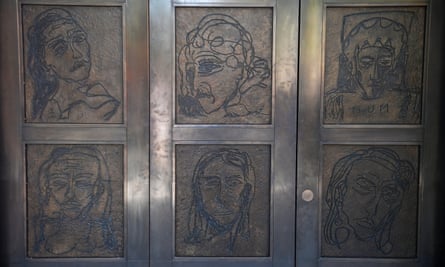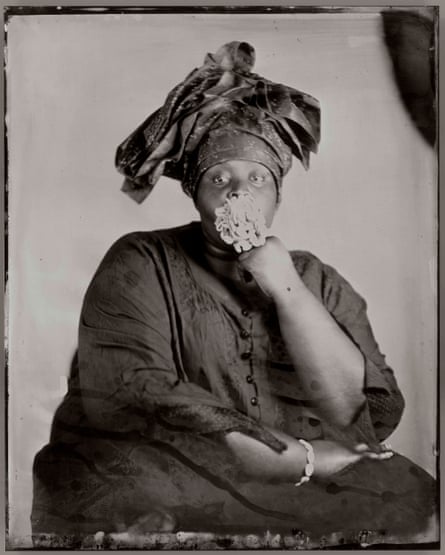Artists in conversation with boxers; playwrights next to composers; royalty juxtaposed with protestors; pop stars talking to Tudors; abolitionists facing suffragettes; pop jostling with expressionism; collage communicating with painting.
Last week, I went to visit the National Portrait Gallery for the first time since it closed three years ago. As a kid growing up in London, it was one of my favourite places. If I had a spare 30 minutes in town, I’d always go in. It was free and I loved seeing the people who lived and shaped this country – from the early 2000s photographs of Zadie Smith to Maggi Hambling’s portrait of Dorothy Hodgkin, the Nobel-winning British chemist, deep in concentration and depicted with four hands: one holding a magnifying glass, one sketching out molecular structures, one holding a card and one pointing out a sentence in a paper.
But after three years of much societal and political change, how did I feel about going back to the gallery that reflects our complicated, crumbling nation? Unexpectedly emotional. Seeing pictures of the people who smashed through ceilings, fought for change, and lived their lives so I can live mine, made me feel hopeful. For the first time in a long time, I felt proud to be British.
Portraits, and the galleries that house them, make us ask questions. Who are the people who have really shaped this nation? Who deserves to be immortalised, to have their stories told, to hang on museum walls for ever? Historically, portraits were painted because the sitter belonged to a certain class, or looked a certain way. But not here. This National Portrait Gallery signifies a new era.
It starts before we’ve even entered the gallery, with 45 bronze portraits by Tracey Emin adorning the doors, like Lorenzo Ghiberti’s Gates of Paradise at the Florence Baptistery. Rather than depicting specific people, her faces instead evoke moods, states of minds – representing, in Emin’s words, “every woman, every age and every culture throughout time”.
Inside, we encounter King Charles III: a large-scale photograph of his piercing blue-eyed gaze meeting ours, his expression tense. The portrait seems to hold all the ambivalence I felt towards this man, who sits at the throne of this nation, a position of power increasingly contested, and yet whose look here has a kindness to it, as though he’s asking us to trust him in this new chapter.
As the wall leads to further, smaller images, the space opens up to show the Britain I know and love; the people I’ve cheered on at the World Cup and Wimbledon; who I’ve sung along with at Glastonbury; whose movies I’ve cried and laughed at; whose exhibitions have made me fall in love with art. It’s the people changing Britain today: Marcus Rashford, Lucy Bronze, Stormzy – in a tender portrait with his mother – Abigail Owuo, Steve McQueen looking pensive, Andy Murray, and a chic Anna Wintour painted by Alex Katz.
But it was when I turned around that my pulse really began to race. I was looking at Work in Progress, a seven-panel mural by pop artist Jann Haworth – who co-created the famous cover of Sgt Pepper’s Lonely Hearts Club Band – and her daughter, Liberty Blake. It’s a monumental work that pays homage to some of the most influential women in history, from Kate Moss to Mary Quant, Ada Lovelace to Vivienne Westwood, Ethel Scott to Kate Bush.

It’s an emotional experience seeing these women together. I owe something to every single one of them. They represent going against the establishment, people who did their own thing, who wrote their own story, and rewrote history. It’s the ultimate cool-girl group that one can only dream to be part of – and the driving incentive to be as history-changing as them.
As I walk around the galleries I learn, and re-learn, about figures from the past: Octavia Hill, co-founder the National Trust, who “believed that access to open spaces would improve people’s health”; Elizabeth Garrett Anderson, the first female medic, who opened hospitals to train women; Lady Butler, whose painting The Roll Call caused a national sensation when exhibited at the Royal Academy in 1874; Mary Seacole, the pioneering nurse.
Downstairs, below the Tudors, it becomes the greatest rock concert on Earth. Elton playing with Bowie; Queen with Pink Floyd. Annie, Dusty, Shirley, Kate. In my head, I’m blasting Bohemian Rhapsody and Rocket Man, Wuthering Heights and Club Tropicana.
after newsletter promotion
But it’s not only this: it’s the pairings and the conversations between the living and the dead; between writers working now and writers working four centuries ago; people whose lives were cut short or who were cast out by the establishment; who grew up on council estates and whose lives more than equal those born in palaces; who, although they never met, can – through their works – have conversations that ring loudly. It’s Angela Carter with Harold Pinter; Gluck with Sarah Lucas; Celia Paul with Issy Wood; Zadie Smith with Queen Elizabeth II; Chantal and Esme with Thelma and Duro; Dame Judi Dench with Amy Winehouse; Malala with Adele.

Then I enter a new room: a sea of self-portraits by female artists, some commanding attention (Sarah Lucas with her splayed legs and eggs on her chest), and others quietly asserting their power (Celia Paul’s introspective gaze, or Gluck’s withdrawn manner). But it’s the self-portrait by Khadija Saye, slotted between Tracey Emin and Ida Kar, that makes this all more meaningful. Saye was 24 when she died in the Grenfell fire, the survivors of which have still not received justice. Saye’s positioning here is not just a way to honour an extraordinary artist, but a reminder of how fraught with failures and inequalities this country still is, and how much needs to be done.
I’ve lived nearly half my life under a government that hasn’t prioritised the education and wellbeing of my generation, with leaders who have driven this country into the ground. But here, at the National Portrait Gallery, it’s not about them. It’s about the people who have had long-lasting influence, who have broken through and made the Britain I grew up in and deeply love. And it excites me, all the people just beginning, not even born yet, who will one day commune with those legends of the past.
This museum is an ode to a country that has birthed writers, dancers, philosophers, scientists and global megastars. It shows that every profession, every story, every background counts. It makes you feel part of something – of culture, history, literature, philosophy, art, music. So go see it. Go see yourself reflected in it, see the Britain we all live in, and the people we can aspire to be like. It’s all possible here. The pictures are evidence.

